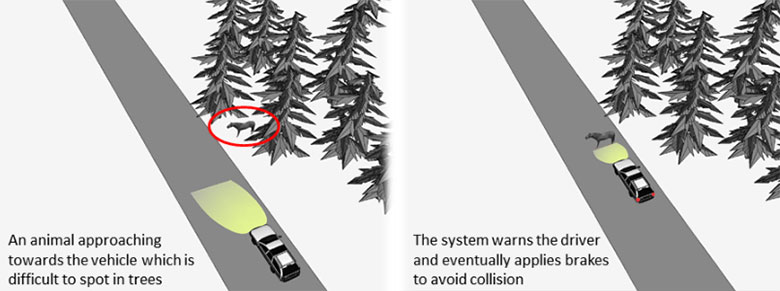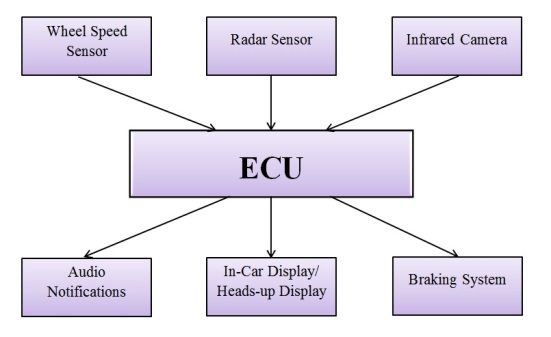Animal Detection System
by Pratik S. Shah, Clemson Automotive Engineering Graduate Student
- Basic Description
-
Animal detection systems use an infrared camera and a radar sensor to detect the presence of animals on the road. On detecting animals the system warns the driver using audio and visual signals. If required the system employs the brakes to avoid a collision. There are over 2 million deer-vehicle collisions per year in the US and Europe. The deer-vehicle collisions cost the United States alone over 3.5 billion dollars. In Sweden, about 47,000 wildlife accidents occur every year. When large animals like moose are involved, the consequences are particularly severe, because the animal's long legs and high center of gravity cause the upper body to strike the car's most vulnerable area, the windshield.

Animal Detection System Operation
The infrared camera and the radar sensor are usually located behind the rear-view mirror. The range of the infrared camera is as much as four times farther than that of the conventional headlamps. They constantly monitor the road for the presence of an animal. The system is programmed to recognize the shape and movements of large animals. The system requires more angles and views compared to pedestrian detection systems. When an animal is detected, an alert is given based on animal location, vehicle speed and other factors.

Animal Detection System Block Diagram
The infrared cameras, radar sensor and wheel speed sensors continually send signals to the electronic control unit (ECU). This unit passes on image signals to the display located in the instrument cluster, the central display or head-up display. During a dangerous situation the ECU sends signals to the speaker and display to warn the driver. It also employs braking to the full braking capacity if required.
Extensive research is currently being conducted to extend the existing database for animal shapes and movement patterns. These systems shall be offered on select models from BMW, Audi and Volvo beginning in 2014.
- Sensors
- Wheel Speed Sensor, Radar, Infrared Imaging
- Actuators
- Display, Speaker, Brakes
- Data Communications
- High-speed CAN or FlexRay
- Manufacturers
- Autoliv, Volvo
- For More Information
- [1] Far Infrared Camera Platform and Experiments for Moose Early Warning System, P. Händel , Y. Yao , N. Unkuri and I. Skog, JSAE Trans., vol. 40, no. 1, 2009.
- [2] Autoliv Night Vision with Animal Detection, YouTube, Nov. 20, 2012.
- [3] Animal detecting systems coming as soon as 2013, Salvador Rodriguez, Los Angeles Times, Nov. 30, 2012.
- [4] Volvo Animal Detection - Vision 2020, YouTube, July 12, 2012.
- [5] Volvo's Animal Detection System, YouTube, July 5, 2013.
- [6] Night Vision with Dynamic Light Spot and Animal Detection BMW Group, YouTube, Oct. 29, 2013.
|

